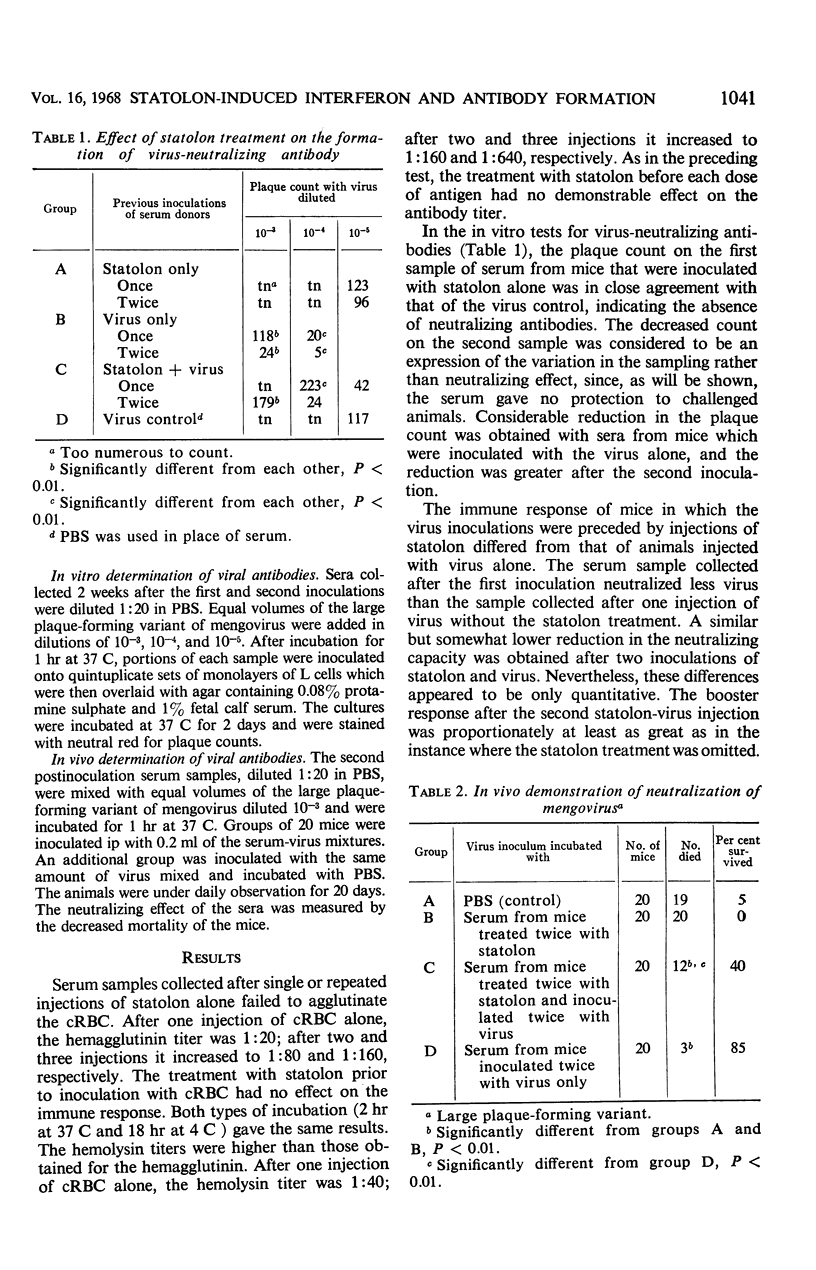Abstract
The effect of statolon-induced interferon on immune response was investigated. Young adult Swiss albino mice were immunized with chicken red blood cells or infectious mengovirus. The red blood cells were injected three times and the virus twice at 2-week intervals, with or without treatment with statolon 24 hr before the inoculations. The effect of interferon on antibody formation was measured by determinations of hemagglutinating, hemolytic, and virus-neutralizing antibodies in the sera of treated and nontreated groups. The hemagglutinin and hemolysin titers after each successive inoculation were equal in both groups, indicating that interferon had no effect on their production. A decrease in the primary response to the viral antigen was associated with interferon induction; the booster response was unaffected. The possible use of interferon inducers as attenuants for immunization with live virulent viruses is discussed.
Full text
PDF



Selected References
These references are in PubMed. This may not be the complete list of references from this article.
- ANDERSON S. G. THE PRODUCTION OF ANTIBODY IN THE PRESENCE OF INTERFERON. Aust J Exp Biol Med Sci. 1965 Jul;43:345–350. doi: 10.1038/icb.1965.67. [DOI] [PubMed] [Google Scholar]
- Colter J. S., Campbell J. B., Hatch L. R. The pathogenicity of mice of three variants of Mengo encephalomyelitis virus. J Cell Physiol. 1965 Apr;65(2):229–235. doi: 10.1002/jcp.1030650209. [DOI] [PubMed] [Google Scholar]
- De Somer P., Billiau A., De Clercq E. Inhibition of antibody production in rats and mice by intravenous injection of interferon-inducing amounts of Sindbis virus or E. coli. Arch Gesamte Virusforsch. 1967;20(2):205–214. doi: 10.1007/BF01241274. [DOI] [PubMed] [Google Scholar]
- Field A. K., Tytell A. A., Lampson G. P., Hilleman M. R. Inducers of interferon and host resistance. II. Multistranded synthetic polynucleotide complexes. Proc Natl Acad Sci U S A. 1967 Sep;58(3):1004–1010. doi: 10.1073/pnas.58.3.1004. [DOI] [PMC free article] [PubMed] [Google Scholar]
- Finter N. B. Interferon as an antiviral agent in vivo: quantitative and temporal aspects of the protection of mice against Semliki Forest virus. Br J Exp Pathol. 1966 Aug;47(4):361–371. [PMC free article] [PubMed] [Google Scholar]
- Finter N. B. Interferon in mice: protection against small doses of virus. J Gen Virol. 1967 Jul;1(3):395–397. doi: 10.1099/0022-1317-1-3-395. [DOI] [PubMed] [Google Scholar]
- Kleinschmidt W. J., Murphy E. B. Interferon induction with statolon in the intact animal. Bacteriol Rev. 1967 Jun;31(2):132–137. doi: 10.1128/br.31.2.132-137.1967. [DOI] [PMC free article] [PubMed] [Google Scholar]
- Lampson G. P., Tytell A. A., Field A. K., Nemes M. M., Hilleman M. R. Inducers of interferon and host resistance. I. Double-stranded RNA from extracts of Penicillium funiculosum. Proc Natl Acad Sci U S A. 1967 Aug;58(2):782–789. doi: 10.1073/pnas.58.2.782. [DOI] [PMC free article] [PubMed] [Google Scholar]
- Pindak F. F., Schmidt J. P. Treatment of mengovirus infection in mice with statolon. Appl Microbiol. 1967 Sep;15(5):1240–1243. doi: 10.1128/am.15.5.1240-1243.1967. [DOI] [PMC free article] [PubMed] [Google Scholar]
- SHOPE R. E. An antiviral substance from Penicillium funiculosum. III. General properties and characteristics of helenine. J Exp Med. 1953 May;97(5):639–650. doi: 10.1084/jem.97.5.639. [DOI] [PMC free article] [PubMed] [Google Scholar]
- Schmidt J. P., Pindak F. F. Statolon-induced resistance of mice to mengovirus. Appl Microbiol. 1967 May;15(3):654–656. doi: 10.1128/am.15.3.654-656.1967. [DOI] [PMC free article] [PubMed] [Google Scholar]
- Shope R. E. An antiviral substance from Penicillium funiculosum. VI. Prevention of the establishment of passive immunity to Semliki Forest virus infection in mice by Helenine. J Exp Med. 1966 Jul 1;124(1):15–31. doi: 10.1084/jem.124.1.15. [DOI] [PMC free article] [PubMed] [Google Scholar]
- TAKANO K., JENSEN K. E., WARREN J. PASSIVE INTERFERON PROTECTION IN MOUSE INFLUENZA. Proc Soc Exp Biol Med. 1963 Nov;114:472–475. doi: 10.3181/00379727-114-28706. [DOI] [PubMed] [Google Scholar]
- Wheelock E. F. Effect of statolon on Friend virus leukemia in mice. Proc Soc Exp Biol Med. 1967 Mar;124(3):855–858. doi: 10.3181/00379727-124-31870. [DOI] [PubMed] [Google Scholar]
- Youngner J. S., Stinebring W. R. Comparison of interferon production in mice by bacterial endotoxin and statolon. Virology. 1966 Jun;29(2):310–316. doi: 10.1016/0042-6822(66)90038-9. [DOI] [PubMed] [Google Scholar]


